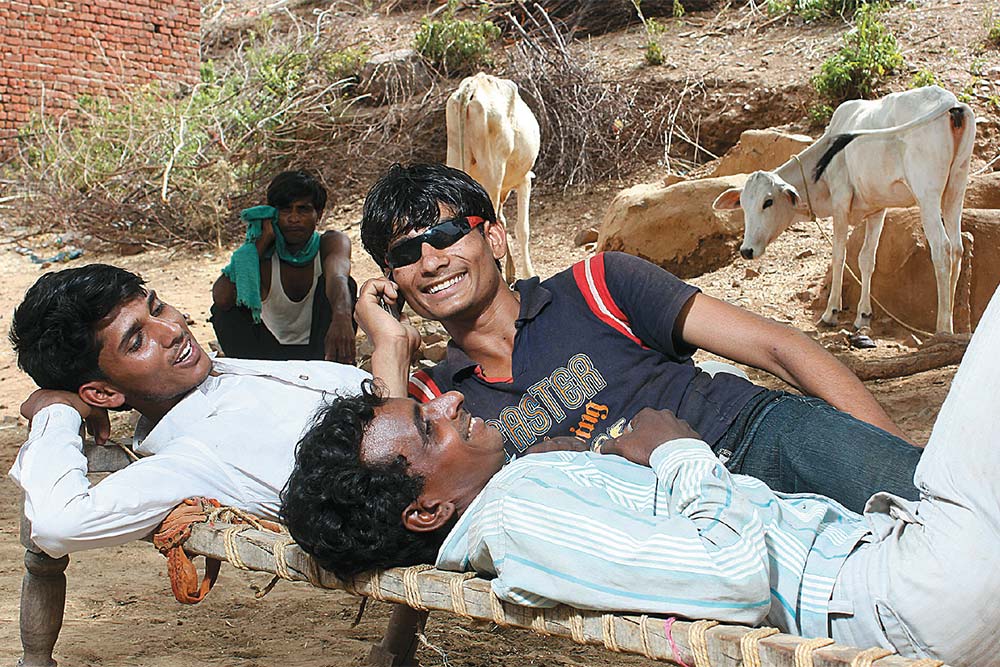Facebook?” wonders Kiran Sharma, an 18-year-old from Manothadi village in Alwar, Rajasthan. “I think I have heard this word in some Hindi film song…” In the village school building, other young people are equally curious to get an answer. The description interests them but they don’t appear convinced that a virtual network can supplant a real one — after all, their village is a social network in itself.
This India is not as far away as we might imagine — Gurgaon is less than 200 km away from Manothadi. But while all young people in Manothadi, and in nearby Ghatikaa, have cellphones, their devices struggle to keep the last bar of coverage alive. No one has heard of the iPhone. “We can afford a phone for ₹1,000-₹3,000,” says Zaffruddin, a 30-year-old. There’s no web and no one has an email account.
Life is a toss-up between farm and school in these remote outposts in the Aravalli Hills, and a lucky few make it to college in nearby Kishangarh Tehsil. There’s a quarry nearby — it’s illegal but there’s employment to be had in it. McDonald’s, anyone? “Rich city lads do that — eating out,” says 17-year-old Rahul. On the other hand, 18-year-old Zuber, a proud collegiate, says, “I like to go to restaurants with my friends.” Others like 20-year-old Darshan Singh wish “to own a better phone that can play music”. But low incomes come in the way of most aspirations.
Money cannot come in the way of cricket, though. The one, boxed-away TV set in Ghatikaa airs the IPL to loyal audiences. “We collect ₹5 from each house to recharge the Tata Sky connection,” says 27-year-old Kasim. Rajasthan Royals are the stars and the house with the TV set is no less than a cinema hall. Young men like Kasim are Salman Khan fans, especially for his muscular physique, but forget a gym, “There is not even a track where you can run in the village,” he complains.
Naturally, the girls want to look pretty, too, even more so if their village is close to the towns. “My sister runs a beauty parlour in Musakheda near Kishangarh,” smiles Kiran Sharma. “It’s always packed.”
My village, our cities
Young Indians in rural corners feel differently about their physical and social distance from ‘shining India’. Aruna Jyoti, 17, travels 50 km from Midchal, a town 50 km from Hyderabad, to her college in Secunderabad every day. Her favourite subject is civics and she wants to be a post-graduate. During vacations, she helps her parents run their store. She has studied computers in college but knows very little about the internet. “I want to become an accountant in a bank because it will be a permanent job,” she says. She likes the city but loves her village even more.
On the other hand, Anji Reddy, 22, does not want to go back to his father’s nine-acre farm. His father had to borrow ₹1.5 lakh for his training at TeamLease/IIJT (an institute in Mehboob Nagar, 100 km from Hyderabad). Now, he wants to change his ‘profile’ and help his father pay off the loan. Anji is currently training at Apollo Pharmacy in Hyderabad but is willing to go where opportunities take him.
Not everyone can take such luxuries for granted. Tirupati is clearly a teenager, but claims he is 40! The anomaly is easily explained. He is suspicious of anyone who approaches him, thinking they could be a government official in search of underage workers — he is barely legal, he confides upon coaxing. The young lad hails from the Ruimuke village in the Nanded district of Maharashtra. His parents are physically challenged and financial problems forced him to drop out of school after class 5. He sells mangoes on the highway to Karimnagar, 110 km from Hyderabad. After the mango season, he will go back to making bricks in a kiln. He has travelled to Madhya Pradesh and Andhra Pradesh in search of a livelihood and knows how to drive a car but thinks he can’t get a licence because “only those who have passed class 10 can get one.”
It’s a scary world out there
The transition from village to city is tougher than it looks. K Sunitha, 20, and Swapna, 19, work at a Café Coffee Day at Cyberabad, the HiTec City. Sunitha had to leave her village because her father’s one acre of land yields too little to support her family. She earns ₹5,300 and sends ₹4,000 home — her family is in debt and they need to save for her sister’s marriage. Sunitha shares accommodation with a group of other girls and recharges her phone with ₹10 every week. She hasn’t been to a mall because, “I am scared of the building and the guards.” Swapna, on the other hand, doesn’t like to travel because she fears trains but she loves her job and wants to become a Café Coffee Day store manager some day.
If some young Indians living in rural areas, like Brajwal Sanjay Kasare, 15, who belongs to a farming family of the Mann village of Hinjewadi near Pune, want to “study hard and become an engineer”, others like Lav Kush, 24, a construction labourer in the same village, simply want to “open a kirana store back home”. It’s the same with Matlem (24), Afzal (17) and Arif (18), who have come all the way from Arariya Court in Bihar to work as temporary labourers in nearby Talegaon. At the end of the day, they go back to the room they share on an empty stretch of NH4, the old Mumbai-Pune Highway, and think about the money needed to go back home.
Then there is Chandrashekhar, a 26-year-old who dropped out of school because his family couldn’t fund his studies. A one-year vocational training course later, he could repair gears and engine valves but found no related jobs. He’s now married and earns about ₹7,000 a month as a security guard with a private firm. Chandrashekhar’s poignant sum-up, though, could be from anywhere in rural India: “Saheb, hum gaaon ke ladke logon mein speed bahut hai, par power nahi.” (“We village boys have a lot of speed but no power.”)












 Just one email a week
Just one email a week